An Ancient Japanese Legend Restored to View: Prince Shotoku in 8K

Levitation is among the miraculous feats ascribed to a child prince who lived more than a 1,400 years ago. (Detail from “Illustrated Biography of Prince Shotoku," a National Treasure of Japan.)
Can technology make for a better museum experience? Arts writer and modern-day Luddite Alice Gordenker takes a "digital viewer" for a spin.
The Gallery of Horyuji Treasures
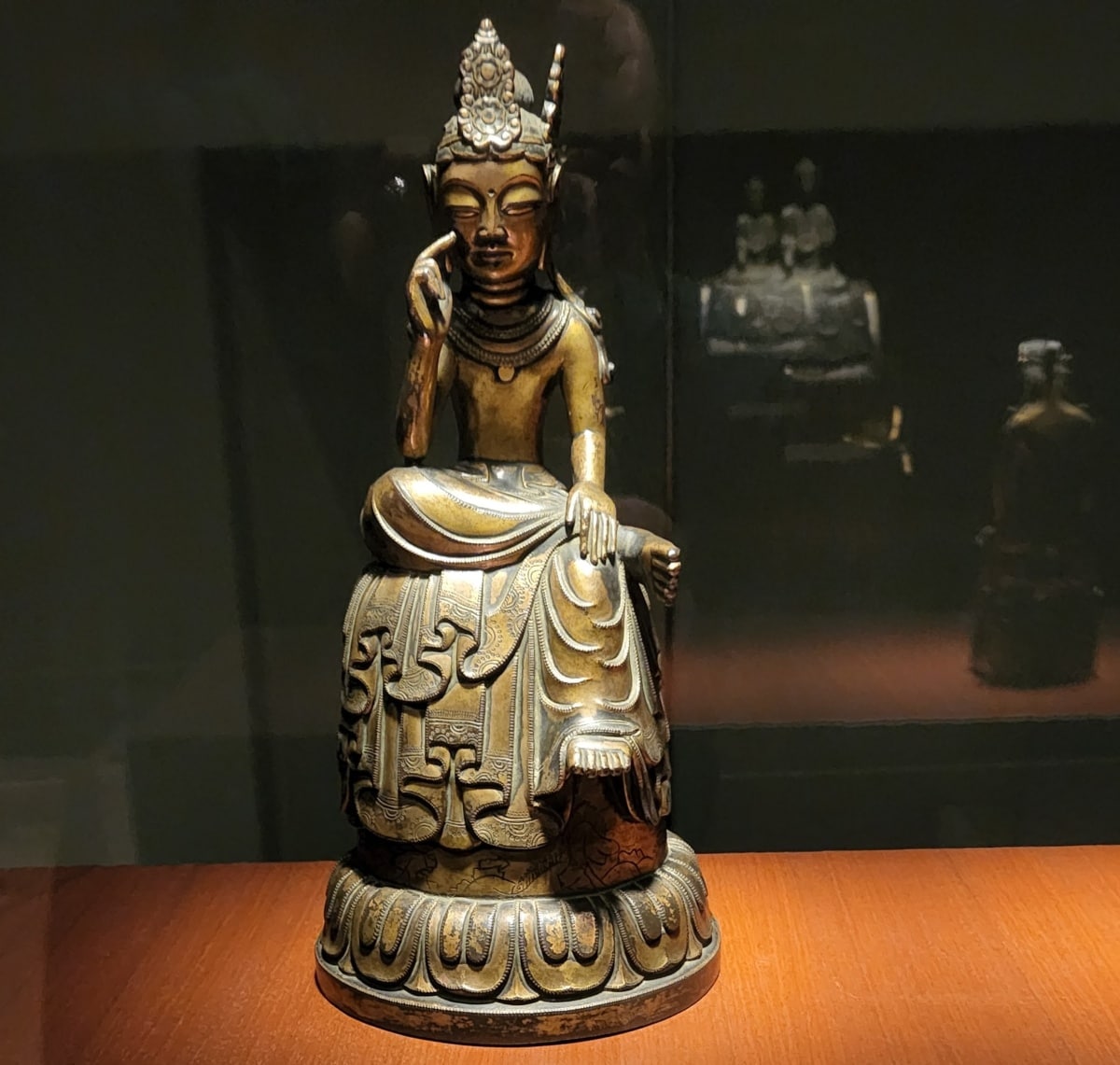
The Horyuji treasures include 48 stunning gilt bronze Buddhist statues, just 30-40 cm high. Seated Boddhisatva with one leg pendent, 7th c., Tokyo National Museum. (Photo by Alice Gordenker)
I’m a skeptic when it comes to technology in museums. Too often, it seems, the touch screens and whizz-bangs just get in the way, and visitors end up fiddling with joy sticks and roller balls instead of using their eyes. So it was with some misgivings that I attended the unveiling of a "digital viewer" at the Tokyo National Museum, in its little-known Gallery of Horyuji Treasures. But what if technology could give us access to masterpieces too fragile for regular exhibition? That, I could get on board with.
The Tokyo National Museum, for those who haven’t been there, isn’t a single building. It’s a complex of several different galleries clustered together on a gated campus adjacent to Tokyo's spacious Ueno Park. Visitors coming for the well-advertised blockbuster shows tend to head straight to the special exhibition halls in the Heiseikan, thus missing the small but eminently worthy Gallery of Horyuji Treasures, nestled out of view in a wooded grove to the left of the main gate.
Masterpiece of Minimalism
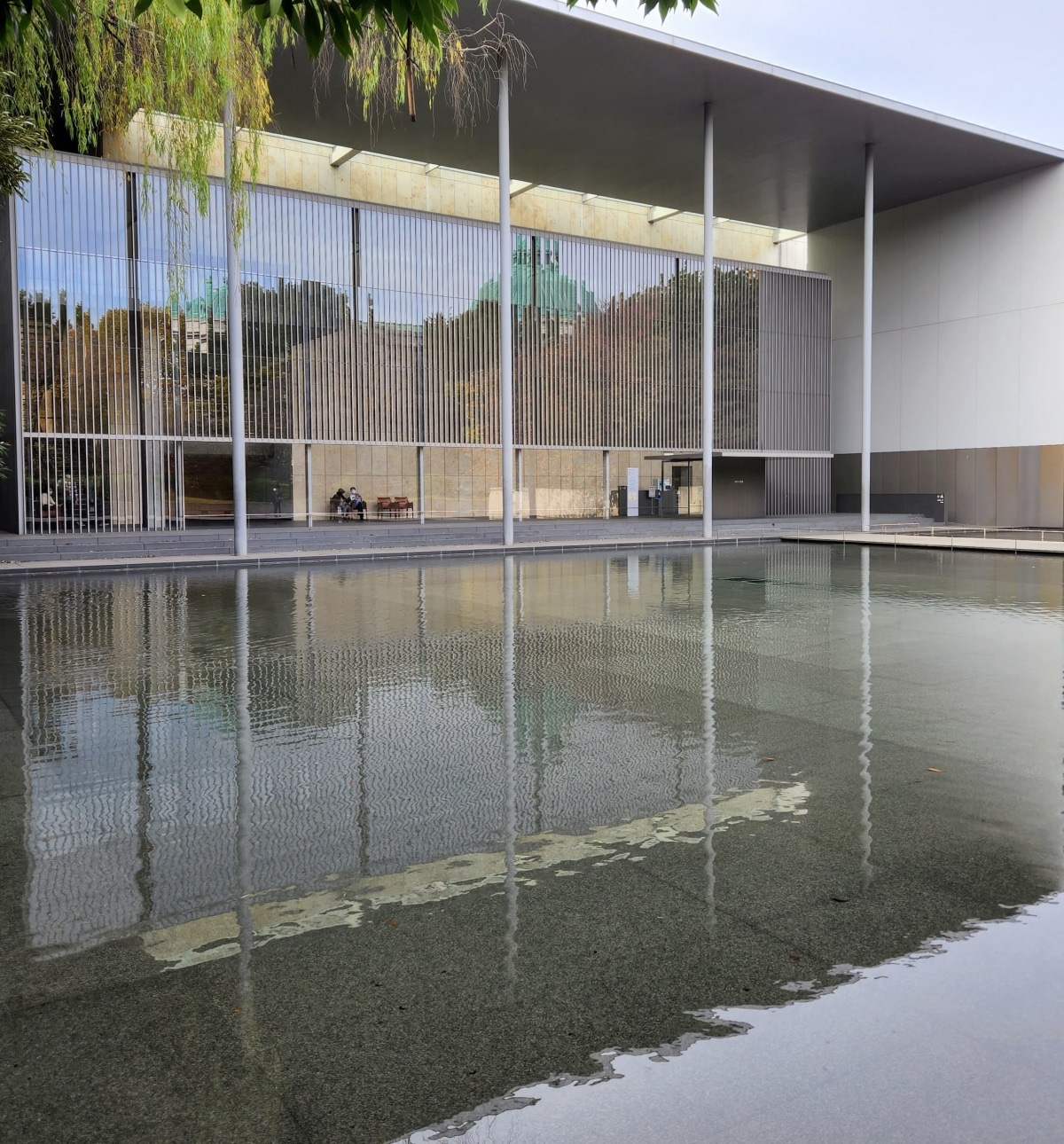
The Gallery of Horyuji Treasures, Tokyo National Museum. (Photo by Alice Gordenker)
The peaceful gallery is a striking example of minimalist architecture, designed by Yoshio Taniguchi, who is best known internationally for his 2004 redesign of MoMA, the Museum of Modern Art in New York. The Gallery of Horyuji Treasures is a slightly earlier work, completed in 1999 to replace an existing building as the permanent home of a collection of some 300 antiquities dating mainly from the 7th and 8th centuries. Known as the Horyuji Treasures, this impressive cache of Buddhist statuary, paintings, textiles and other rare artifacts was presented to the Imperial family in 1878 by the Horyuji temple in Nara. It is the only collection within the Tokyo National Museum's holdings with its own building. Access is included in regular admission, so it's easy to stop by when coming to the Tokyo National Museum for another exhibition. But for anyone with an interest in architecture or Buddhism, the Gallery of Horyuji Treasures is worth a special trip.
New Exhibition Space
The Digital Gallery of Horyuji Treasures presents high-quality reproductions of antiquities too fragile for full-time display.
I went for a press preview of new exhibition space on the mezzanine floor, designed specifically to share high-quality reproductions and interactive digital content related to the collection. Titled the "Digital Gallery of Horyuji Treasures," the exhibition is a joint production of the Tokyo National Museum and the National Center for the Promotion of Cultural Properties, which uses technology, including high-resolution digital images and virtual reality, to improve access to masterpieces of Japanese art that are too fragile for regular display. For its first run, from Jan. 31 to July 30, 2023, the new gallery presents life-size reproductions of an 11th-century painting in the gallery's collection that once adorned sliding doors inside Horyuji temple. Titled "The Illustrated Biography of Prince Shotoku," it narrates across 10 panels the life of the temple's founder, Prince Shotoku.
Prince Shotoku lived from 574 to 622, roughly the same time as the prophet Muhammad and Pope Gregory I. He was, by all accounts, a forward-thinking and open-minded man, credited with writing Japan's first constitution and greatly encouraging the spread of Buddhism. Revered in his lifetime, legends arose over successive generations endowing him with super-human abilities and even anointing him as a reincarnation of the Buddha. By the time the "Illustrated Biography of Prince Shotoku" was painted in 1069, some 450 years after his death, the hagiography was well developed. Among the 58 episodes chosen by the artist to relate the Prince's life are scenes of him levitating and flying a horse up Mt. Fuji. The Horyuji painting is not the only work to tell the story of Prince Shotoku, but it's the oldest and largest.
The Illustrated Biography of Prince Shotoku
Visitors can get as close as they like to the panels. There are no barriers or glass to obstruct viewing.
You may be wondering why the museum went to all the effort and expense of creating a reproduction when it's got the real thing right there in its own collection. That's a fair question. Simply stated, it's because the original is too fragile for regular exhibition. There are strict rules regulating the exhibition of National Treasures, with limitations on the number of times a work can be exhibited in a given year, as well as the number of days it can be on display. For historical works deemed in danger of damage by light or movement, the regulations are even more restrictive. The original panels of the "Illustrated Biography of Prince Shotoku," being particularly delicate, can only rarely be put on view, and it's particularly difficult to set up a space that's large enough to accommodate all 10 panels while maintaining a suitably protective environment.
Thus, the reproductions. They were made from high-resolution photographs and printed on a synthetic fabric that closely mimics the original silk backing. They are sturdy and durable, certainly when compared to the original, so there's no need to dim the lights or put them in a climate-controlled case. This means visitors can move in to peruse details as closely as they wish.
Enhanced Viewing, in 8K Clarity
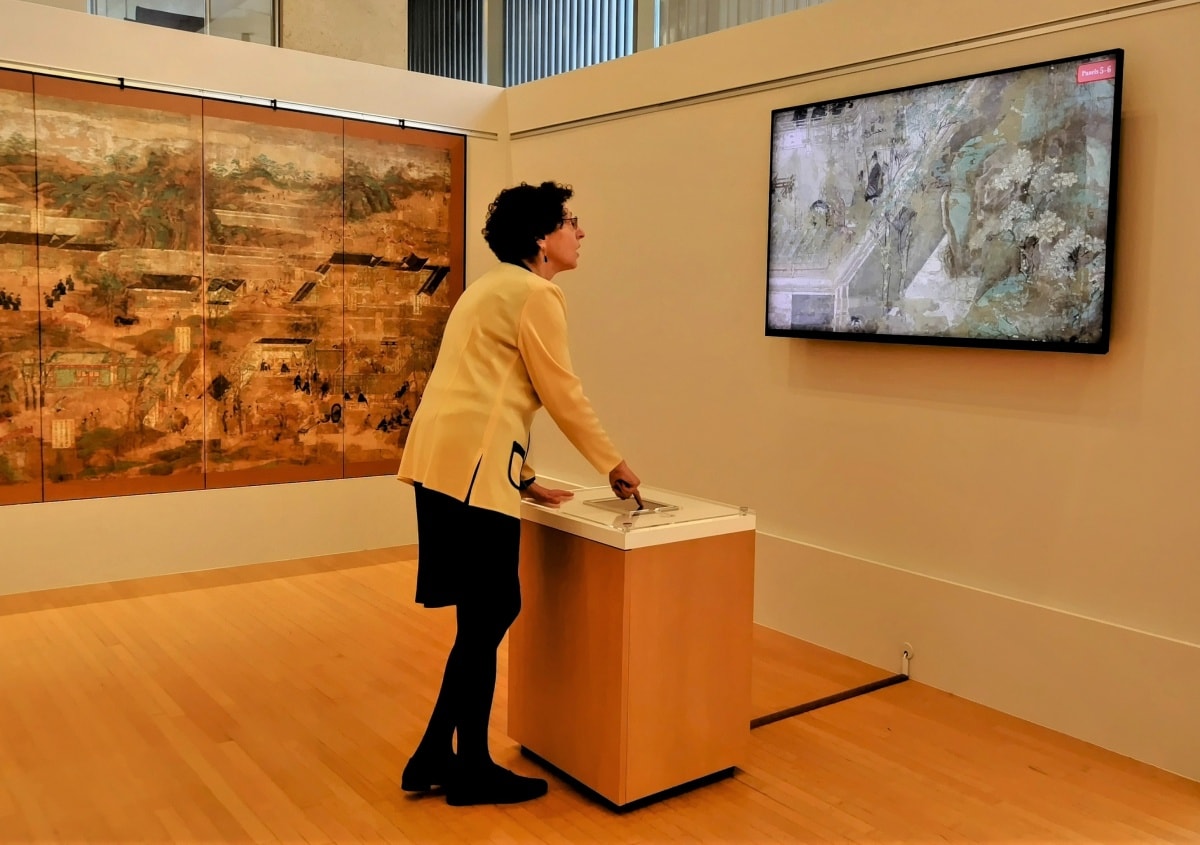
The author successfully manipulates a digital image to zoom in a favorite scene, greatly magnifying the details.
Despite the favorable viewing conditions—good light and no glass—it's still tough to figure out what you're seeing. Keep in mind that the reproductions present the work as it was nearly a thousand years after it was painted. There's no denying that the years have taken a toll. Colors have faded, pigment has flaked away, and the damage is faithfully recorded in the reproductions. Adding to the challenge, it's pretty difficult for modern viewers, even those versed in Japanese history and culture, to grasp the significance of details in clothing and architecture that would have meant more to people centuries earlier.
To help overcome these obstacles to full appreciation, the museum developed what it calls a "digital viewer," a console controlled by the visitor that presents digital images on a nearby 70-inch screen with 8K resolution. The viewer can select a specific scene to explore, enlarging it many times and zooming in on details that aren't visible with the naked eye. And if you want explanation, you can tap to pull up written commentary. There are two consoles, one set for Japanese and the other in English.
Nearly Lost: the Kondo Hall Murals
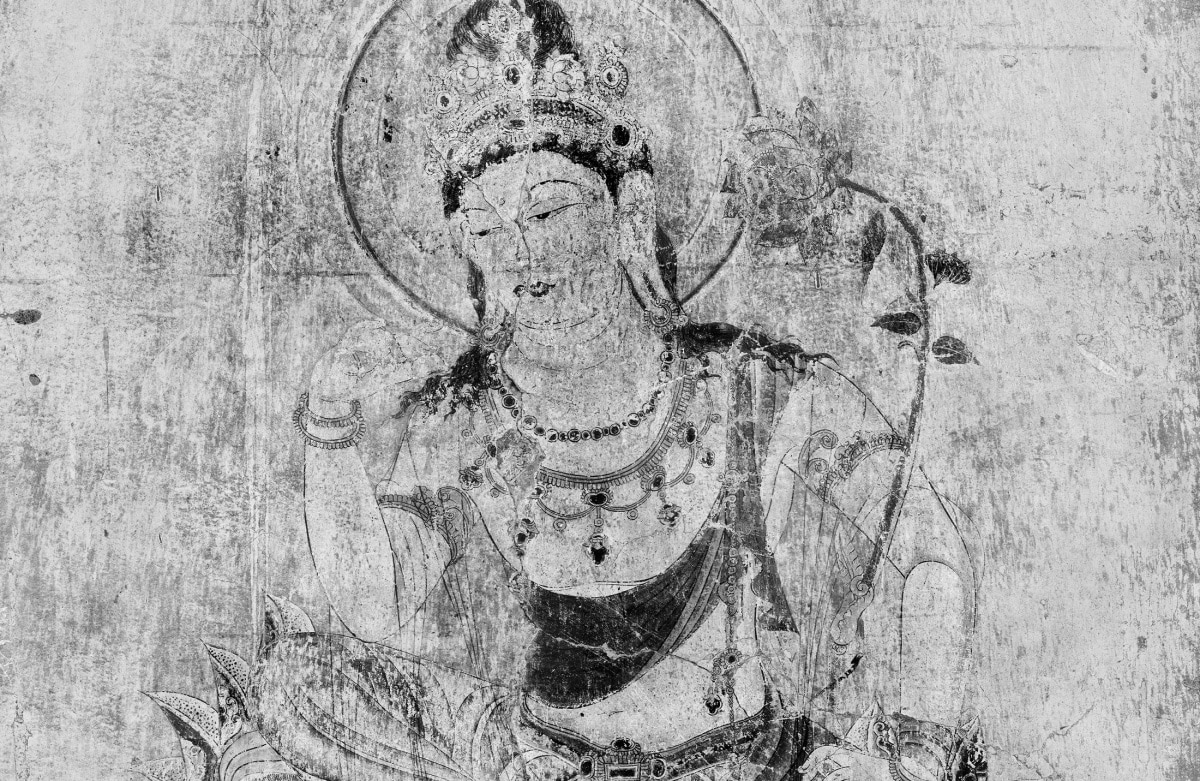
A digital image from a glass photographic plate made in 1935: Mural No. 2, Bodhisattva (detail) in the Kondo Hall of Horyuji Temple, Nara.
Mid-summer, the digital gallery will get a change of exhibits, with the focus shifting to different work, a series of Buddhist murals that once decorated inner walls of Horyuji's Kondo Hall. Believed to have been painted between the latter half of the 7th century and the early 8th century, the murals—long considered an especially fine example of early Buddhist art in Asia—were severely damaged in 1949 when a fire broke out in the temple. The near-total loss of this masterpiece was reported in the news as a national tragedy, the only consolation being that a detailed photographic record had been made a few years earlier.
Following the disaster, top painters of the day used those photographs to create a close facsimile, which is what now adorns the inner walls of the Kondo Hall. But the original glass photographic plates were carefully preserved and have now been restored and digitized. Images made from the plates are available online in a nicely interactive gallery, but the upcoming exhibition at the museum will offer a better view. From Aug. 1, 2023, until Jan. 28, 2024, the Digital Gallery of Horyuji Treasures will present the images on large panels arranged around the room in the same order and roughly the same size as the original murals. There will also be the same opportunity to use the digital viewers to select and enlarge the images, permitting exploration in highly magnified detail.
Oldest Wooden Masks in the World
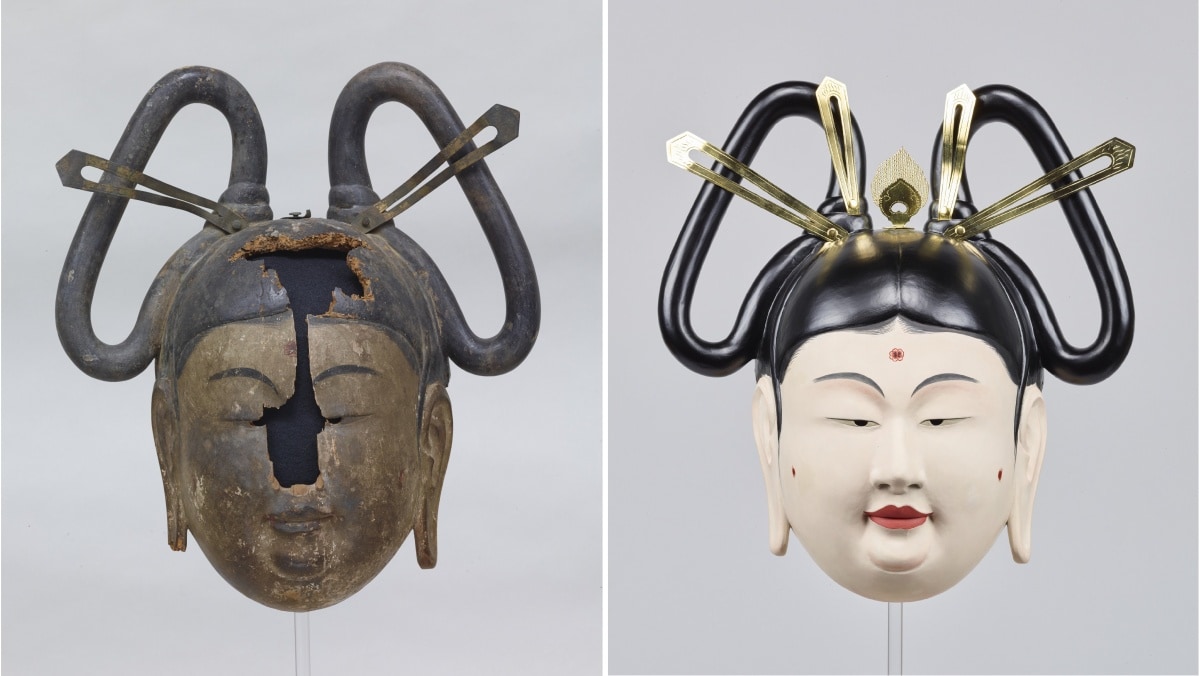
The "Woman of Wu," an original Gigaku mask (left) dating from the 7th c., and a reproduction that shows us what it may have looked like when new.
For me, one of the most exciting things I learned on my visit is that the Horyuji treasures include a collection of original Gigaku masks. Gigaku was a Buddhist performing art introduced to Japan from the Asian continent in the early 7th century, during Prince Shotoku's lifetime. Much is unknown about Gigaku because its popularity waned over the ensuring centuries, and it died out completely in the Kamakura period (1192-1333). But based on written texts and inscriptions on masks, Gigaku is believed to have incorporated music, pantomime, and masked dancers in colorful costumes, performed to entertain visitors to temples and share Buddhist teachings, in an easy-to-understand and often humorous way. In the Gallery of Horyuji Treasures, the original Gigaku masks are kept in a special room that is only open on Fridays and Saturdays. The limit on access is to preserve the works, which are thought to be the oldest surviving wooden masks in the world, dating from the latter half of the 7th c. and early 8th century.

Using barely surviving fragments of an original Gigaku costume in the Horyuji Treasure collection (left), the museum recreated the sort of skirt once worn by court ladies.
To help visitors understand what the masks may have looked like when new, the museum has created careful reproductions of two of the most interesting masks in the collection. A section of the new exhibition space has been set aside for the display of these re-creations, along with reproductions of costumes based on fragments of originals in the gallery's collection. Initially on view is a reproduction of the "Woman of Wu" mask and a sort of skirt a female character may have worn. From Aug. 1, 2023 until Jan. 28, 2024, a reproduction of a Garuda bird-deity mask will be offered with a robe like those worn by some male characters. Thereafter, the two selections will alternate on six-month rotations.
Don't miss the video playing on a wall-mounted screen next to the mask case, which explains the effort that went into making the reproductions and includes the only footage I've ever seen of a modern re-enactment of Gigaku. In a laudable move to open access to everyone, the museum has shared a longer and more detailed version online.
See For Yourself
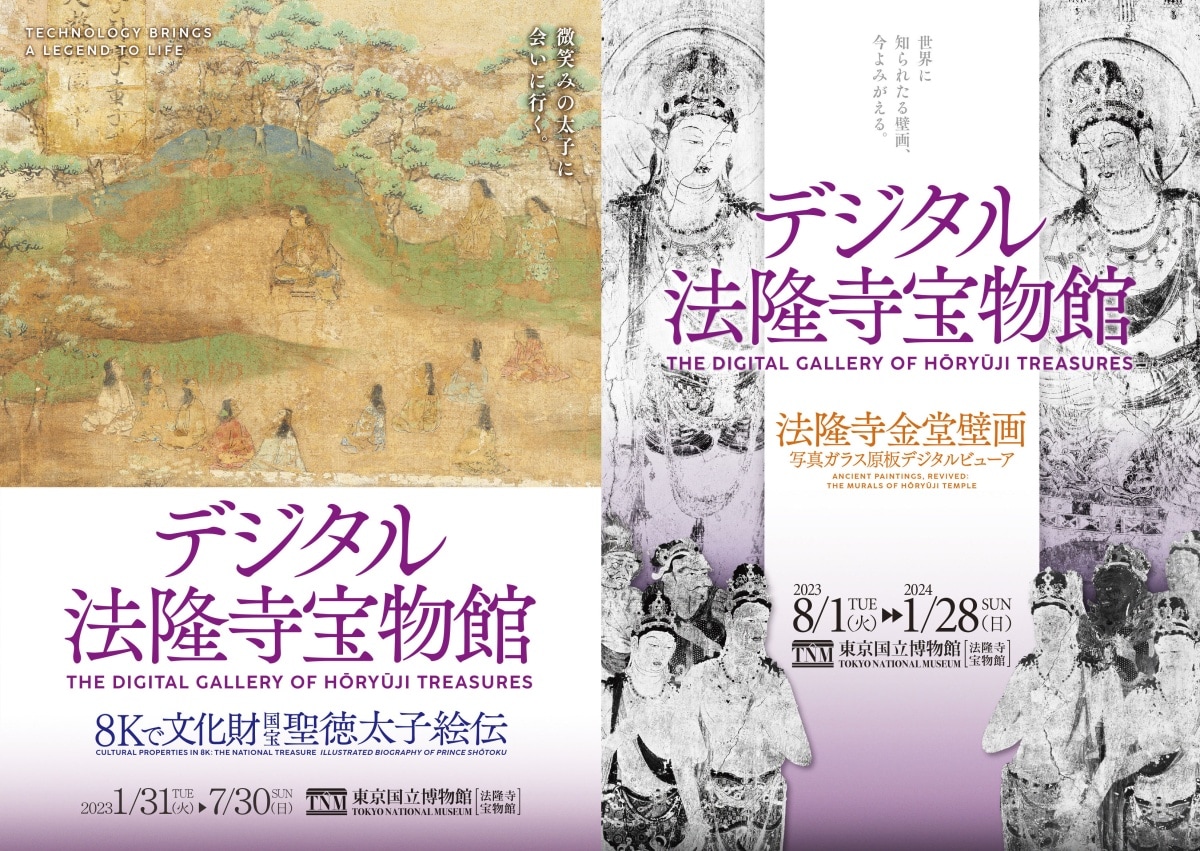
Key exhibition visual: The Digital Gallery of Horyuji Treasures, Tokyo National Museum
Cultural Properties in 8K: The National Treasure "Illustrated Biography of Prince Shotoku"
Jan. 31-July 30, 2023. (Kondo Hall murals from Aug. 1, 2023)
The Digital Gallery of Horyuji Treasures
The Gallery of Horyuji Treasures, Tokyo National Museum
13-9 Ueno Park, Taito-ku, Tokyo, 110-8712
Google Maps
Hours 9:30 a.m.-5:00 p.m. (last admission 4:30 pm)
Access
- (JR Yamanote line) 10 mins. walk from Ueno or Uguisudani Station
- (Ginza or Hibiya Tokyo Metro subway line) 15 mins. walk from Ueno Station
- (Chiyoda Tokyo Metro subway line) 15 mins. walk from Nezu Station
- (Keisei Line) 15 mins. walk from Keisei Ueno Station
Regular admission to Tokyo National Museum, including the Gallery of Horyuji Treasures adults: 1,000 yen; university students, 500 yen; free with ID for persons with disabilities and one attendant, and persons under 18 and over 70.
Images of works in the collection of the Gallery of Horyuji Treasures courtesy of the Tokyo National Museum, unless otherwise credited. All other images © Alice Gordenker.
Videos linked to in this article have subtitles available in English, Korean, Chinese and Japanese. To view with subtitles, toggle on the CC (closed captioning) setting on your YouTube screen and use the "gear" icon to set the subtitles to the language of your choice.
Other Articles on Japanese Art by Alice Gordenker
Why I Love Nihonga (and Want You to Love It Too)
A 'New' Museum for Your Kyoto Bucket List
Nine Treasures of Japan You NEED to See.
Winter at the Adachi Museum of Art: Superb Rosanjin Collection
California Transplant on Mission to Save Japanese Crafts
The Life of Hokusai, As Seen in the Collection of a Remarkable Museum



